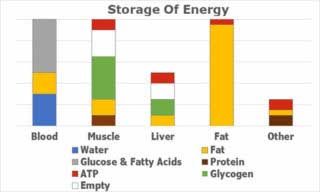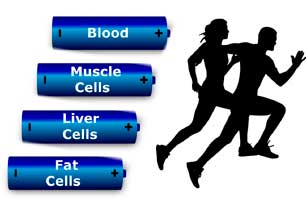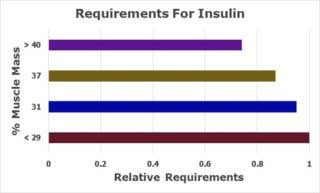Telehealth Reverse Diabetes Powered By Exercise | Free Trial In Texas

Exercise lowers toxic effects from high levels of sugar and fat in the blood. It also decreases the amount of insulin required to clear sugar and fat from the blood.
It’s the storage capacity of muscle after exercise that speeds a quicker response. Exercise burns calories, too. So build muscle and use it.
Visit our website: www.herdhealthcare.com, or call us at 713-669-0271 to get started on an action plan for good health.
Skeletal Muscles At Work
Sources Of Energy
The fuel for muscular work comes from food we eat and drink. There’s carbohydrates (starch and sugar), fat (fatty acids and triglycerides), protein (amino acids and globulins) and alcohol. The nutrients we consume are converted by stomach, intestines and liver into molecules that are transported in blood. Metabolism is what extracts energy from fuel for active cells to do their work.
Storage Of Energy
The engine of an automobile runs on one fuel (gasoline) stored in one place (gas tank). Living cells use one form of energy (ATP) that metabolism extracts from 3 or 4 types of molecules using several different processes. These molecules are stored in various places in various amounts in every tissue.
 The end result is that we don’t just step on an accelerator to feed fuel from a tank. Skeletal muscle has several tanks with different fuels all coming down to one form of energy for work.
The end result is that we don’t just step on an accelerator to feed fuel from a tank. Skeletal muscle has several tanks with different fuels all coming down to one form of energy for work.
Energy in one form or another is stored in:
• blood
• muscle cells
• liver cells
• fat cells
Speed Of Delivery
 Skeletal muscle is always primed with energy and ready to contract. It starts work immediately on command. First using energy in carriers with ATP but those stores last only 10 or 15 seconds.
Skeletal muscle is always primed with energy and ready to contract. It starts work immediately on command. First using energy in carriers with ATP but those stores last only 10 or 15 seconds.
Almost immediately, metabolism starts converting energy stored in glucose and fatty acids to take over. As active work continues for several minutes, glycogen is converted to glucose and fat is converted to glycerol and fatty acids.
Response To Insulin
Skeletal muscle is highly receptive to high levels of glucose and fatty acids in the blood. Increased levels of insulin facilitate entry of glucose and fatty acids into muscle cells. It also promotes glucose storage as glycogen and storage of fatty acids as triglycerides.
When enough energy has been stored to supply immediate requirements, skeletal muscle cells no longer take in glucose and fatty acids. That’s it! No more for now! Excess calories have to go somewhere else!
Storage Of Excess Calories
When levels of glucose, fatty acids and insulin stay high, the storage of energy shifts glucose and fatty acids into fat tissue everywhere. In some tissues, more fat is just more stored energy. In other tissues, like heart muscle, liver and pancreas, more fat eventually degrades function.
High levels of insulin not only promote movement of glucose and fatty acids into fat cells they also stimulate formation of new fat cells to store glucose and fatty acids until amounts circulating drop to normal safe levels.
Daily Demands For Energy
During ordinary daily living activities, most of the demands for use and storage of energy are met with movement of glucose and fatty acids in and out of blood.
After meals, abrupt increases in sugar, fat and protein are reduced by storage in glycogen and fat in muscle and liver. If those stores are full, levels of sugar and fat stay high until eventual storage in other fat tissue.
During exercise, most of the energy is drawn from glycogen and fat stores in muscle and liver. During prolonged, strenuous exercise, energy also is drawn from stores in fat tissue all over the body
At night, stores of glycogen and fat in muscle and liver are replenished by whatever remains from high levels of sugar and fat in the blood during the day. When those stores are filled, remaining high levels of sugar and fat are cleared into fat tissue all over the body.
When amounts in blood reach normal safe levels, energy required for brain, kidneys and other organs is supplied by glucose released from glycogen stores in liver and fatty acids from other fat stores.
Practical Application Of Metabolic Balance
The ideal metabolic system tightly controls sugar, fat and insulin levels in blood. In particular sustained high levels of insulin greatly increase risk for heart disease, stroke and cancer. Increased levels of insulin inevitably accompany restricted storage space for glycogen in skeletal muscle.
The amount of glycogen in skeletal muscle and liver is about 500 grams–an energy equivalent to about 2000 calories. Capacity for storage in liver glycogen after fasting overnight is about 50 grams or 200 calories. During normal daily activities, an additional 200 or 300 calories can be stored as fat.
The ideal balance between calorie intake and energy expenditure has an upper limit of about 500 calories per day. Excess calories above 500 delays return of insulin to basal levels at night. However, prolonged strenuous exercise extends the limits of tolerance for several days.
Exercise Recommendations
Health and Human Services recommends 150 minutes per week of moderate intensity aerobic physical activity along with at least two days a week of muscle-strengthening exercises.
 Analysis of clinical studies in U.S. and Europe shows that people who have a regular exercise program have about half the risk for cardiovascular disease as people who don’t do any exercise. People who exercise regularly gain about 5 years of good health over people who don’t.
Analysis of clinical studies in U.S. and Europe shows that people who have a regular exercise program have about half the risk for cardiovascular disease as people who don’t do any exercise. People who exercise regularly gain about 5 years of good health over people who don’t.
Exercise for Reversing Diabetes is less effective than decreasing body weight. But exercise has a good effect. It can contribute 15% or 20% to the benefit of decreasing weight in reversing diabetes. As a result, less weight reduction is required to reverse diabetes if exercise is included as part of good health practice.
Clinical Studies Of Regular Exercise in Type 2 Diabetes
Combinations Of Endurance and Strength
The effect of exercise on requirements for insulin was studied in several hundred subjects. Men and women with type 2 diabetes participated in 16 clinical studies.
Those studied all included various combinations of endurance and strength training. All had at least 3 sessions of moderate or vigorous exercise every week. All who exercised had the same calorie intake as their comparison group.
Even though there were vast differences in types and intensity of exercise, all groups had similar results. Those who exercised improved effectiveness of insulin by about 40% compared to sedentary subjects.
These benefits of decreased requirements for insulin lasted at least 3 days after each day of exercise.
Skeletal Muscle Mass
The importance of skeletal muscle mass in determining requirements for insulin has been shown. A total of 13,644 men and women with and without type2 diabetes were studied in the National Health and Nutrition Survey. These subjects had a range of muscle mass relative to body size from <29% to >40%.
 The Figure shows 4 groups with differences in relative muscle mass between groups of about 6%. These data show that requirements for insulin decreased as % muscle mass increased. Each 10% difference in skeletal muscle mass had about 11% reduced requirements for insulin.
The Figure shows 4 groups with differences in relative muscle mass between groups of about 6%. These data show that requirements for insulin decreased as % muscle mass increased. Each 10% difference in skeletal muscle mass had about 11% reduced requirements for insulin.
In addition, each 10% difference in relative skeletal muscle mass had about 12% reduced risk of developing diabetes during a period of 6 years.
Recommendations For Exercise
Endurance Training (3 or 4 days/week)
Examples of endurance training (Aerobic Exercise) are:
• walking
• running
• bicycling
• swimming
• rope jumping
Begin by testing maximal effort you can sustain for 6 minutes. Then start endurance training at 50% of effort exerted during 6 minute exercise test.
Continue exercise until you feel you could do as much again without rest.
Strength Training (2 or 3 days/week)
 Examples of strength training are:
Examples of strength training are:
• push-ups and squats
• stretching resistance bands
• free weights
• stationary weight machines
Begin by testing to find the maximal effort you can exert 1 time only. Then start strength training at 50% of maximal 1 time effort with 5 repetitions.
Rest about 1 minute then repeat 5 reps, rest 1 min, then 3rd set of 5 reps.
Work towards 10 repetitions in each set.
Maintain Muscle Mass While Reducing Weight
Limit Weight Reduction To 1 to 2 lb/week
Reducing body weight more than 1 to 2 lb/week makes it more likely to lose skeletal muscle mass as well as fat. Gradual reduction in weight is less likely to cause loss of muscle mass.
For most people, this means maintain total caloric intake of at least 1,200 calories each day.
Increase Protein Consumption
Increasing amount of protein consumed each day greatly reduces loss of skeletal muscle mass. Amount of protein consumed should be at least 100 grams every day.
For most people, this means doubling the usual amount of protein consumed each day.
The most convenient way to increase intake of protein is with milk protein powder dissolved in water. Convenient amounts of powder and water are 1 scoop of about 30 grams in 8 ounces of water.
Strength Training
 Emphasize the amount of strength training in relation to endurance exercise. Both are important. Both types of exercise consume calories and draw down amounts of glycogen stored in muscle and liver.
Emphasize the amount of strength training in relation to endurance exercise. Both are important. Both types of exercise consume calories and draw down amounts of glycogen stored in muscle and liver.
However, strength training helps maintain muscle mass while decreasing caloric intake to reduce body weight.
We are pleased to share our blog articles with you, and we are always interested to hear from our readers. Our website address is: www.herdhealthcare.com






